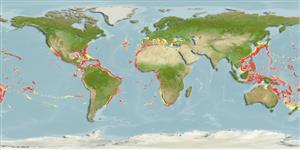Common names from other countries
Environment: milieu / climate zone / depth range / distribution range
Écologie
; profondeur 100 - 1250 m (Ref. 104052), usually 230 - 730 m (Ref. 104052). Subtropical
Indo-Pacific, Atlantic Ocean and the Mediterranean: from Angola to northwest coast of Spain, and in the Mediterranean from the Alboran Sea, Crete Island, and Aegean Sea.
Length at first maturity / Taille / Poids / Âge
Maturity: Lm ? range ? - ? cm Max length : 12.8 cm TL mâle / non sexé; (Ref. 104052)
Life cycle and mating behavior
Maturité | Reproduction | Frai | Œufs | Fécondité | Larves
Members of the order Decapoda are mostly gonochoric. Mating behavior: Precopulatory courtship ritual is common (through olfactory and tactile cues); usually indirect sperm transfer.
Williams, A.B., L.G. Abele, D.L. Felder, H.H. Hobbs Jr., R.B. Manning, P.A. McLaughlin and I. Pérez Farfante. 1988. (Ref. 2214)
Statut dans la liste rouge de l'IUCN (Ref. 130435)
statut CITES (Ref. 108899)
Not Evaluated
Not Evaluated
Utilisations par l'homme
Pêcheries: intérêt commercial mineur
| FishSource |
Outils
Sources Internet
Estimates based on models
Preferred temperature
(Ref.
115969): 6.1 - 15.7, mean 9.2 (based on 685 cells).
